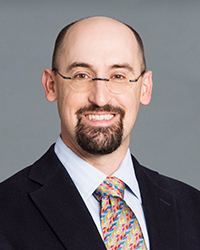
Mark E. Nunnally, MD, FCCM
When COVID-19 numbers spiked in New York City last spring, it was bigger than anything doctors there had ever seen before. It demanded ingenuity and the ability to adapt and skillfully steer through a learning curve at record speed. Doctors are still trying to process mentally, physically, and logistically everything that has happened since then, but are ready to share some of what they learned on the frontlines.
During Monday’s session “COVID Experiences From the First Wave,” Mark E. Nunnally, MD, FCCM, and Thomas Jan, MD, MPH, both Critical Care Anesthesiologists at NYU Langone Health in New York City, will present their experiences during the massive COVID surge in their hospital system and share experiences and tips for managing a complex problem.
New York City was, by far, hit harder by COVID than any other city in the United States. As it became the epicenter for coronavirus infection, hospitals there transformed into COVID treatment units.
COVID Experiences From the First Wave
10-11 a.m. CT
Saturday, October 3
“In Manhattan, Brooklyn, and out on Long Island, the COVID footprint was really large. COVID became all we did. I heard it described somewhere along the way as ‘all COVID, all the time.’ And that’s exactly right,” Dr. Nunnally said.
As medical centers conformed to COVID, they quickly adapted spaces, reevaluated work schedules, and tried to determine how to logistically deal with PPE shortages.
“We had the benefit of having a new hospital pavilion that was built only 18 months before the first wave hit,” Dr. Nunnally said. “We had rooms that could be turned into ICU rooms quite easily.”
Filling those rooms with medical staff was a little more difficult. Dr. Nunnally said that they had to come up with rotation schedules that fully utilized staff but also ensured that people were resting or in reserve so that they could be fresh for their shifts.
Hospitals also drafted and recruited more medical staff anywhere they could, he said.
“We were able to repurpose providers because normal operations had been reduced, so we repurposed them to the cause,” Dr. Nunnally said. “Then we recruited. We graduated medical students early and promoted fellows who had completed the critical care part of a composite fellowship.”
Increasing the number of medical staff also increased the need for PPE, which was in short supply. Doctors were re-using equipment where they safely could, getting every bit of use out of it. They kept their N95 masks in paper bags and used them for as long as possible to reduce burn rate, Dr. Nunnally said.
All the while, they were aggressively trying to get new PPE and the disposable items needed to take care of patients, he said. “There were under-par products hitting the market and prices were soaring. Our supply chain people did a great job of finding things.”
Even though the logistics were challenging, it was the physical and mental strain that were the most difficult for those going through a crash course in COVID.
“I remember in the first big week when we were expanding quickly and opening new units, I took pause because I never remember my mind being so active before. I was hypervigilant. Days would go by in minutes. I remember thinking, ‘This can’t be good in the long term, I’m not designed to rev this high,’” Dr. Nunnally said.
Months later, he is experiencing sleep disturbances and anxiety over when a COVID surge could strike again. He watches the news and tracks the numbers. Any uptick brings back what he describes as that “old familiar feeling” of needing to prepare for a worst-case scenario.
“We’re all still trying to unpackage this mentally. It’ll be a while before we know what the toll of this was,” Dr. Nunnally said.
Return to Index